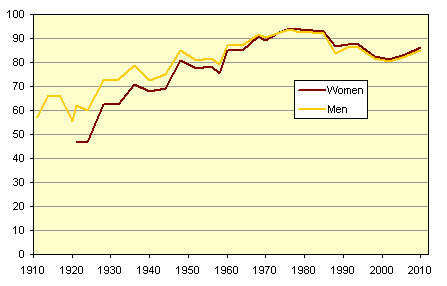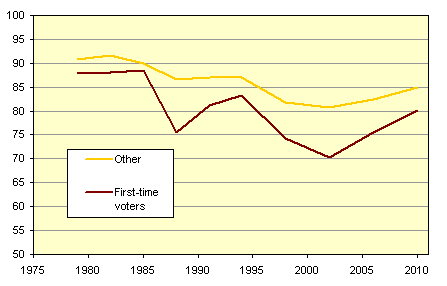General elections, electoral participation survey 2010:
Higher election turnout
Statistical news from Statistics Sweden 2012-12-06 9.30
The percentage of voters has increased in the last two elections. The voter turnout has even become more equal. At the same time there are still differences among different groups in the population. Foreign born persons and young people take part to a lesser degree. Young people are not so well represented in selected parishes and terminate their assignments to a greater extent.
Statistics Sweden has been assigned by the government to study Swedish election turnout over time and in different groups. Young people in the democracy have also been studied. These studies have resulted in the reports "One hundred years of Swedish voter turnout" and "Young people and the democracy", that are being published by Statistics Sweden today.
Women vote to a greater extent than men. The difference today is only one percentage point in total, but women's election turnout is clearly higher for persons younger than age 60. Seen from a longer time perspective this means a considerable change. Women were given the right to vote in the Riksdag election in 1921. At that time election turnout was 47 percent among women and 62 percent among men. During the entire first half of the 20th century men voted to a considerably higher degree than women did. However, the difference decreased over time and since the 1960s the differences between the sexes have been small.

There are significant differences between various groups in the population. The percentage of voters is lower among persons who are single, have a low level of education, have a low income level, are blue collar workers, unemployed and persons outside of the labour force. Conversely, the percentage of voters is greater among cohabiting adults, highly educated persons, persons with high incomes, white collar workers and employed persons.
Election turnout is considerably lower among persons who are foreign citizens and among foreign born Swedish citizens. This situation also applies even when a number of other factors have been considered, such as education and income.
Between 1994 and 2004 election turnout dropped sharply in Swedish elections, which in many ways implied a more unequal voter turnout. This was because the downturn in election turnout above all occurred in those groups that took part in elections to a lesser degree even earlier. The percentage of voters has increased in the last two elections. In the 2010 Riksdag election, election turnout amounted to 84.6 percent, which involved an increase of 4.5 percentage points in relation to the 2002 election.
Above all, the increase has occurred in those groups that have a comparatively small share of voters, which has meant that voter turnout has become more equal. However, the differences in voter turnout between the different groups are greater today than in the beginning of the 1990s.
Lower voter turnout among young people
When looking at age groups, we see that voter turnout is lower among the youngest and oldest persons. The differences concerning age are smaller today than what they were 60 years ago when Statistics Sweden began studying the percentage of voters by age. But they are larger than during the 1970s when voter turnout in total was highest.
A group that is particularly interesting is the group of first-time voters in the Riksdag election, that is, persons who have reached voting age since the previous Riksdag election. This is a group where voter turnout develops in the same way as among others, but the changes from election to election are greater. For instance, the downturn in election turnout that occurred between 1994 and 2002 was considerably greater among first-time voters. At the same time, the upswing that has occurred in the two last elections is correspondingly more significant. 80 percent of the first-time voters took part in the 2010 Riksdag election, which was 5 percentage points lower than other age groups. The difference in the 2002 election was 10 percentage points.
Among first-time voters, women vote to a greater extent than men. The difference was about 3-4 percentage points in the last three Riksdag elections.

Few young people among elected representative
The interest to discuss politics is not less among young people than among those in other age groups. However, young people are not well represented among elected representatives. In the 2010 general elections, persons under age 30 accounted for 19 percent of those entitled to vote. However, only 5 percent of those elected to the Riksdag were under age 30. The corresponding figures for county councils were 6 percent and 7 percent in municipal councils.
Compared to older persons, it is more common for young people to leave their positions in municipal or county councils before the end of the term. This is above all the case for women. Few Riksdag members left their assignments during the previous term, and among those who did, differences in age and sex are smaller.
Publication
Results from the surveys and further information is presented in the reports One hundred years of Swedish voter turnout and Young people and the democracy.
Statistical Database
More information is available in the Statistical Database
Feel free to use the facts from this statistical news but remember to state Source: Statistics Sweden.
